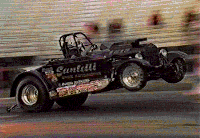

Talk
about wear and tear on a tire. Wear can be defined as the unwanted
progressive loss of substance from the surface of a body brought about
by a mechanical action from the rubbing of one surface against another.
Abrasion, wear, and scratch resistance are all similar and are closely
related to friction. The ploughing component of the frictional force
is quite similar on a microscopic scale to tearing. When an elastomer,
rubber tires, move over a surface such as asphalt, large deformations can
occur where the asperities of the road contact the tire. In some
cases even blowout can occur. The same holds true for composites
of all types when subjected to various levels of friction.
In the abrasion process, high friction occurs and thus heat is generated
just as if you rub your hands together vigorously. These high temperatures
produced in localized areas produce large localized stresses and strains.
At these hot points, chemical reactions, such as oxidation and degradation,
can occur which speed up the rate of abrasion or wear. Such a process
can be seen as corrosive wear and are not solely mechanical. Most
of the work on abrasion and wear has been done on flooring, tires, and
other rubbers. Many testing instruments have been developed for materials.
Common abrasion machines include:
1. Taber
abrader (ASTM D1044)
2. Armstrong
abrader
3. Olsen
Wear-Ometer (ASTM D1242)
4. NBS
abrader (ASTM D1630)
5. DuPont-Grasselli
abrader (ASTM D394)
The table below lists relative wear of some plastics.

|
|
|